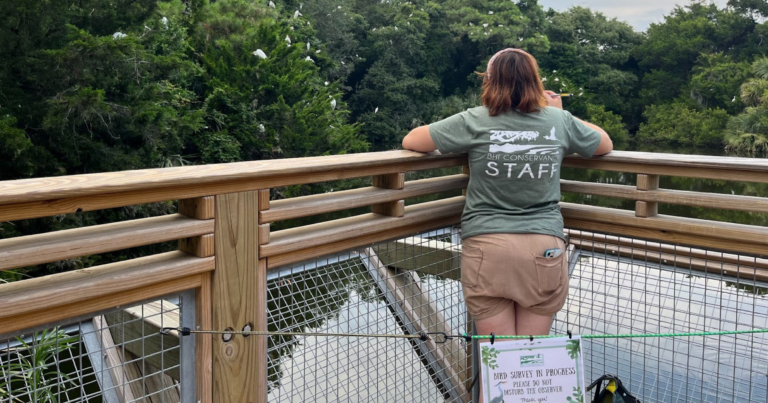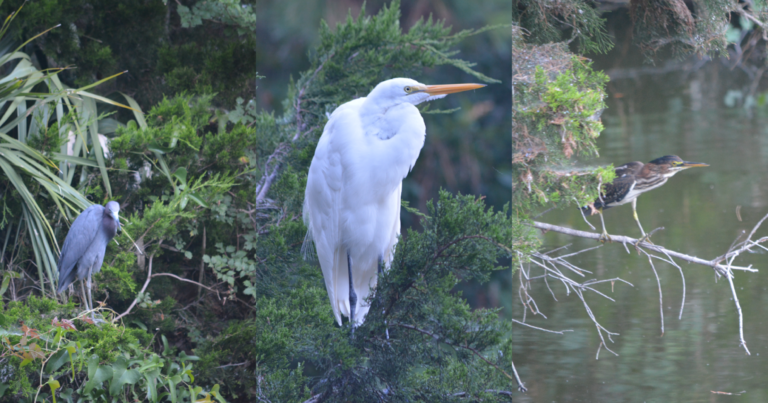From Sanctuary to Overlook: Unraveling the Mystery of Bald Head Island’s Roosting Birds

by Katie Barton, Conservation Intern (Summer 2023)
Hello, readers! My name’s Katie Barton, and I’m a former Conservation Intern at the Bald Head Island Conservancy. This December I will be graduating from The University of North Carolina Wilmington, where I’m double-majoring in Biology and Environmental Science, with a concentration in environmental conservation. For my intern project, I worked on a joint research project with my fellow Conservation Intern, Elena Kelly. We looked at how wildlife biodiversity differs between two ponds of drastically different water quality: the Ibis Sanctuary pond on Middle Island and the Wildlife Overlook on Stede Bonnet Road.

Middle Island Exploration, one of the nature tours offered by the Bald Head Conservancy, takes visitors to the iconic Ibis Sanctuary. This wetland used to be a picturesque birding hotspot as hundreds of ibis, egrets and herons came in to roost every night. Nature enthusiasts could also expect to see other wildlife living off the water, namely alligators and aquatic turtles, and hear entire symphonies of chorusing frogs. In recent years, however, there has been a noticeable decline in the number of roosting birds and other wildlife sightings at the Ibis Sanctuary. Meanwhile, birds began to flock in waves to the Wildlife Overlook, drawing dozens of guests to watch the birds fly in every night. But why the change?

A running theory is that a change in water quality is to blame. Around the same time the birds began to disappear from the Ibis Sanctuary, duckweed, a type of aquatic plant, began to grow on the surface of the water. While we lack historical data on water quality at the Ibis Pond, we can compare the current water quality between the Ibis Pond and Wildlife Overlook to identify any drastic differences. This summer, we took water measurements—very carefully—from each site using the same methods as our weekly creek water assessments (which you can read more about here). Permission to kayak at both sites was granted by the Village of Bald Head Island. Rest assured: no staff, interns, or alligators were harmed in the implementation of this project.

The second part of our project was wildlife diversity. We conducted standardized surveys to observe the presence of alligators, turtles, amphibians, and roosting birds. We did weekly surveys at each site to look for freshwater turtles and alligators. Elena collected data on the frogs and toads using acoustic surveys, while I looked into the roosting bird mystery through an observational study.
I conducted two two-hour surveys each week, one per site. Between 6:30 and 8:30 PM, I documented how many individuals of each species arrived at the roosting site and am using this data to determine species richness (number of species) and evenness (abundance across species), both of which factor into overall biodiversity. In addition to biodiversity data, I hoped to determine the most active period at the Wildlife Overlook and temporal patterns of arrival to share this information with birding enthusiasts.

I have found that the birds typically start arriving at the Wildlife Overlook around 6 PM (approximately two hours before sunset), and continue to come in waves until it gets dark. They’ll roost there all night until sunrise, when they take to the skies again. Based on my findings, I suggest visiting the Overlook sometime between 7:30 and 8:00 PM, when multiple groups – as large as fifty or more birds – can be seen flying in together. The vast majority of these birds are White Ibis, although they tend to roost deeper in the trees and more out-of-sight. This is as opposed to the second most common species at the Overlook, the Great Egret, which typically roost front-and-center, perfect for viewing. Other species you can reliably find at the Overlook are Snowy Egrets and Little Blue Herons, which often fly in after the first group of White Ibis and Great Egrets have arrived. If you’re lucky, you might see a Tricolored Heron, Yellow-crowned Night Heron, Green Heron, or even a Roseate Spoonbill!
The Ibis Sanctuary is a very different story. If you have access to the pond, your best chances are to visit between 8 and 8:30 PM when the birds fly out from their hiding spots deep within the trees. You can expect to almost exclusively see Black-crowned Night Herons, and the occasional White Ibis or Great Egret. My personal favorite Ibis Sanctuary residents are the Anhingas (also known as “Snakebirds”), which zip through the trees of the pond at blink-and-you’ll-miss-it speeds. As I expected, the Ibis Pond has far less biodiversity than the Wildlife Overlook, and a drastically different number of birds. I saw an average of only thirty birds per night at the Ibis Pond, while I saw an average of over 500 per night at the Wildlife Overlook; on my final night of data collection at the Wildlife Overlook, I counted a whopping 750 individual birds!

In addition to collecting biodiversity data, I developed a catalog of behaviors called an ‘ethogram’ that included various pre-defined behaviors relating to habitat use, as well as interactions between birds, namely physical displacement. By looking at these factors, I want to see how the sheer number of birds at the Wildlife Overlook may disrupt the roosting process, which could ultimately stress out the birds. This decision arose because I was wondering if the large number of birds that previously roosted at the Ibis Sanctuary inspired a mass exodus, and if we might expect a repeat situation with the Wildlife Overlook in a couple of years once these numbers pass a theoretical threshold (or “carrying capacity,” as ecologists call it). I hope to use the behavioral data I have collected for my Environmental Science senior seminar project at UNCW and continue to look into the mystery of Bald Head Island’s roosting birds.
I would like to thank the Bald Head Island Conservancy for giving me such an amazing opportunity and a summer I’ll never forget!
Location: P.O. Box 3109, 700 Federal Rd. Bald Head Island, North Carolina 28461 EIN#: 58-1574496
Phone: Office: (910)-457-0089
Email: info@bhic.org
Hours:
- Monday9AM - 5PM
- Tuesday9AM - 5PM
- Wednesday9AM - 5PM
- Thursday9AM - 5PM
- Friday9AM - 5PM
- Saturday9AM - 5PM
- Sunday9AM - 5PM

